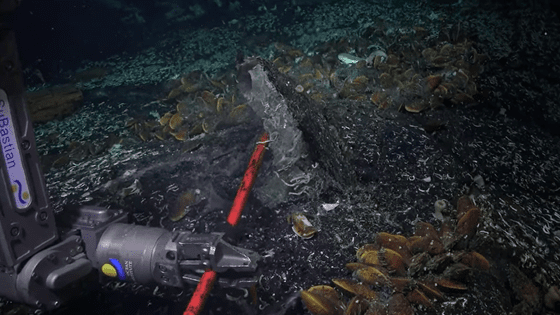hydrothermal ventis a crack in the earth that spews out geothermally heated water, and the temperature of the spouted water can reach several hundred degrees, and it is characterized by containing substances harmful to living things, such as heavy metals and hydrogen sulfide. . However, even in such extreme environments, living things can live, and a survey conducted by the Schmidt Ocean Institute in the East Pacific Ridge revealed that when searching for cavities around deep-sea hydrothermal vents,tube wormIt has been reported that such creatures have been discovered.
Animal life in the shallow subsea crustfloor at deep-sea hydrothermal vents | Nature Communications
https://www.nature.com/articles/s41467-024-52631-9
Ghostly white giant worms appear to be reproducing under the seafloor where tectonic plates meet | Live Science
https://www.livescience.com/animals/ghostly-white-giant-worms-appear-to-be-reproducing-under-the-seafloor-where-tectonic-plates-meet
In areas of active volcanism, hydrothermal vents form when water seeps through cracks in the ocean floor, comes into contact with magma, and ejects as a boiling, mineral-rich liquid. Most of the deep sea floor is considered inhospitable for most living things, but around hydrothermal vents a group of organisms known as “extremophiles” that can survive under extremely high temperatures and pressures are erupting. They live on food such as minerals.
Previous research has shown that underground areas around hydrothermal vents areConfirmed that microorganisms existHowever, no large animals such as tube worms were confirmed to be living there. The research team dropped a remotely operated unmanned vehicle (ROV) into a hydrothermal vent at a depth of approximately 2,515 m in the eastern Pacific Ocean near the Galapagos Islands in order to observe organisms lurking beneath the seafloor of a hydrothermal vent. They then used an ROV to drill a hole in the ocean floor and lifted the debris with an arm, revealing a cavity approximately 10 cm deep.
By watching the video below, you can see how the ROV actually investigates the ocean floor.

Not only were many adult tubeworms, which can reach up to 50 cm in length, living in the cavities, but there were also signs that they were breeding there.
The research team said, “For the first time, we have confirmed the existence of animals in small cavities beneath the seafloor of deep-sea hydrothermal vents.” The presence of microorganisms and viruses under the seafloor of deep-sea hydrothermal vents has previously been confirmed. “However, it has now become clear that there are animals living there as well.”
Furthermore, the research team found that tubeworm larvae were dispersed throughout multiple cavities, “some of which migrated beneath the ocean floor and settled in hydrothermal vents through cracks leading from the cavities to the surface; We speculate that the insect remains in the cavity and becomes an adult.” On the other hand, it is not clear how swarms of tube worms living under the seafloor maintain the ecosystem.
Copy the title and URL of this article
・Related articles
It turns out that a completely unknown ecosystem is spreading under the “hydrothermal vent” where high-temperature water spouts from the ocean floor – GIGAZINE
More living things live in the extreme environment thousands of meters underground than on land or in the ocean – GIGAZINE
Deep-sea exploration vessel successfully captures video of “Flying Spaghetti Monster” on the ocean floor off the coast of Chile – GIGAZINE
It turns out that “dark oxygen” is generated in the deep sea where light does not reach, and new questions about the origin of oxygen-consuming organisms – GIGAZINE
Are there any places on Earth where there is no life? -GIGAZINE











